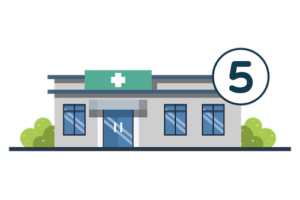Annual Revenue Practices Miss Without Patient Pre-Registration Solutions
By Blakely Roth | October 18, 2023
Patients are seeking quicker access to care and streamlined check-in options, while healthcare providers strive to reduce the associated staffing and collections burdens.
A post recently went viral, where an oncology patient shared how traumatic it is for patients with a cancer diagnosis to constantly fill out forms. While oncology patients come into the office far more regularly than general specialty healthcare patients, reports show nearly 50% of patients want the ability to check in or complete health forms before arriving. Judging by how viral that initial post went, that number could be increasing.
One powerful solution that is changing the game is pre-registration, which not only helps practices meet the demands of today’s patients but also has significant implications for practice revenue. See how you can increase practice and physician-earned profits while providing care to more patients every day and reducing staff workloads (skip to the bottom for a calculation!)
Sounds too good to be true, but it’s a step high-growth practices are already driving results from.
Pre-Registration Benefit to Patients
Practice are building a foundation for efficiency and improving their ability to expand by providing patients with a modern clinical intake experience. They’re implementing a digital patient pre-registration approach that includes clinical intake. The key is to find a solution that enables your patients to complete all the necessary demographic and medical history information, including pre-screeners and consents, in advance, from anywhere, anytime!
Imagine a scenario where patients can breeze through the check-in process in 90 seconds or less. That’s the magic of pre-registration. It’s not limited to repeat visitors; with the right solution, even new patients can enjoy this expedited check-in experience. By offering pre-check to patients, you can drive a reduction in check-in times by anywhere from 50-95%.
Traditionally, expedited check-in was reserved for returning patients. However, passwordless and portal-free pre-registration levels the playing field, ensuring that every patient, whether new or returning, receives expedited service. By enabling patients to conveniently check in from the comfort of their homes, you reduce their time spent in the office and get them back to your providers faster, which can leave additional time in a day for more patients to come in.
In a conversation on “How Top-Performing Practices are Modernizing Clinical Intake”, Patient Access Assistant Manager at Nebraska Orthopaedic Center, Sydnie Murphy, shares, “With pre-registration and clinical intake taken care of at home, we can accommodate more patients every day, which helps us get patients to their doctor faster and meet our providers’ desired patient volumes. We can continue to bring more surgeons into our practice and keep patient throughput efficient, which has been a big help.”
How Self-Service Registration Improves Staff Workloads & Payment Collection
For healthcare practices, the benefits are equally compelling. Lines at the reception desk can cause stress among staff and inconvenience for patients. In some cases, the check-in process for new patients alone can exceed 20 minutes. Existing patients often find themselves waiting in these lines, leading to bottlenecks, while staff struggle to capture patient information, manually input data into their systems and ask patients for payment, further increasing patient and staff anxiety.
By implementing patient pre-registration with clinical intake, the majority of patient data capture can take place by the patient outside of the office — dropping check-in times, lines and awkward staff conversations. With practices seeing upwards of 59% utilization of pre-check, they reduce the majority of staff involvement in patient registration. Couple pre-registration with in-office, self-service patient check-in kiosks, and you can drop staff involvement in registration by upwards of 90%, reducing the menial tasks that hinder staff efficiency and lead to burnout. Self-registration also reduces staff involvement in the collections process, which has been shown to increase collections by giving patients a quick and private way to make payments. Nebraska Orthopaedic Center sees 81% of co-pays paid monthly.
Staff members are no longer tied up managing lines, processing paper documents or manually updating records. Instead, the entire check-in process becomes streamlined, taking 90 seconds or less, which not only minimizes patient wait times but also creates a more efficient, stress-free work environment for staff. Murphy goes on to share the benefits her staff has seen at Nebraska Orthopaedic Center, “Our front-desk staff has been able to focus more on the patients. They used to rush to figure out what clinical intake information patients needed to finish and then hand out an iPad so they could get to the next patient in line. Now, they’re able to genuinely interact with patients and help them feel more comfortable.”
The Return-on-Investment of Patient Pre-Registration
From a financial perspective, offering pre-registration has been shown to increase the number of patients seen by healthcare providers. In Nebraska Orthopaedic Center’s case, the practice dropped average check-in times by 47% and now accommodates more patients every day, which is a huge benefit for their practice as they’ve added two additional providers.
Just like in Nebraska Orthopaedic Center’s case, efficiency translates into more patients seen daily, which can significantly impact practice revenue. At Clearwave, we’ve historically seen clients achieve increases in patient numbers ranging from 1% to 5% or more! While that may not seem large, let’s see these improvement rates put into perspective:
Missed Revenue Without Self-Service Registration & Pre-check
Example of a Practice’s Current State:
Consider a group earning $100 per patient with 20 patients per doctor, resulting in a daily revenue of about $2,000 per doctor.
Example of a Practice’s After State:
With a 5% increase in patients seen by each doctor, the daily patient count rises to 21, generating $2,100 per doctor per day. This represents an increase of $100 per doctor per day.
If a healthcare practice employs 10 doctors, implementing pre-registration and self-service options could boost their overall daily revenue by $1,000.
Let’s say you have 260 average operating days in a year (average days in a year without weekends and holidays), your practice could earn $260,000 more revenue per year.
Patients Want Pre-Check, Practices Need Pre-Check
By integrating pre-registration with clinical intake and self-service registration solutions into your practice, you can not only boost profits but also improve patient and staff retention for the long term — which is key to furthering your success. As the healthcare environment continues to evolve, embracing innovations like these can lead to better patient care and a healthier bottom line for providers. Put time and money back into your practice with Clearwave Registration, see how!
Recommended for you
Related Posts
Long-Lines Giving You Blurry Vision?
Reading Time: 4 minutes Clearwave & Thomas Eye Group’s 10-Year Partnership Puts Patients First By Blakely Roth | June 18, 2024 In an era…
3 Ways to Gastroenterology Practices Use Patient Check-in Software to Augment Staff Workloads
Reading Time: 4 minutes By Chloe From Clearwave | June 13, 2014 The healthcare industry is battling a multi-faceted workforce crisis, and no specialty…
5 Ways Family Medicine & Primary Care Practices Can Increase Patient Acquisition
Reading Time: 6 minutes By Chloe From Clearwave | June 3, 2024 Family medicine and primary care practices serve as the front line of…




